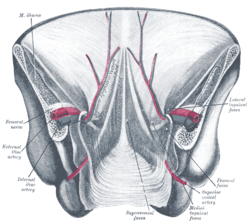| Lateral umbilical ligament | |
|---|---|
 Posterior view of the anterior abdominal wall in its lower half. The peritoneum is in place, and the various cords are shining through. | |
 The peritoneum of the male pelvis. | |
| Details | |
| Identifiers | |
| Latin | plica umbilicalis lateralis; plica epigastrica |
| TA98 | A10.1.02.434 |
| TA2 | 3796 |
| FMA | 16537 |
| Anatomical terminology | |
The lateral umbilical fold is an elevation (on either side of the body) of the peritoneum lining the inner/posterior surface of the lower anterior abdominal wall formed by the underlying inferior epigastric artery and inferior epigastric vein which the peritoneum covers. Superiorly, the lateral umbilical fold ends where the vessels reach and enter the rectus sheath[1] at the arcuate line of rectus sheath; in spite of the name, the lateral umbilical folds do not extend as far superiorly as the umbilicus.[2] Inferiorly, it extends to just medial to the deep inguinal ring.[citation needed]
Each lateral umbilical fold is situated lateral to the ipsilateral medial umbilical fold. Unlike the median and medial umbilical folds, the contents of the lateral umbilical fold remain functional after birth.[2]
- ^ Standring, Susan (2020). Gray's Anatomy: The Anatomical Basis of Clinical Practice (42th ed.). New York. p. 1156. ISBN 978-0-7020-7707-4. OCLC 1201341621.
{{cite book}}: CS1 maint: location missing publisher (link) - ^ a b Sinnatamby, Chummy (2011). Last's Anatomy (12th ed.). Elsevier Australia. p. 234. ISBN 978-0-7295-3752-0.